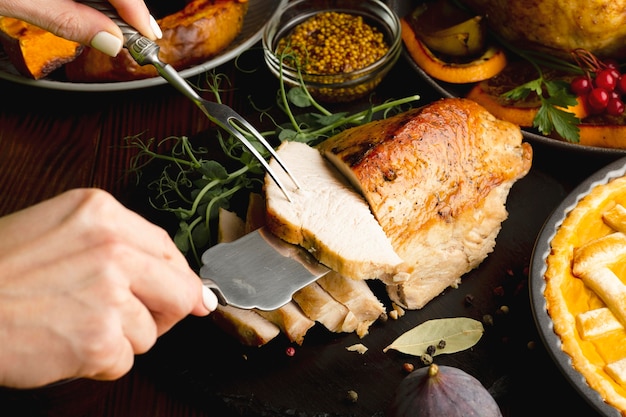(Part 1) The Foundation: Building Your Kitchen Arsenal

Essential kitchen tools: Your Culinary Toolkit
- A good set of knives: You can't conquer the culinary world with dull blades. A sharp chef's knife for chopping, a nimble paring knife for delicate tasks, and a sturdy bread knife for slicing are must-haves.
- Cutting board: Choose a sturdy board that won't slip around, like a trusty companion in the kitchen.
- Mixing bowls: A set of various sizes will handle all your culinary creations, from whipping up a simple salad dressing to mixing batter for a decadent cake.
- Measuring cups and spoons: Precision is key, especially when baking. You want those cookies to come out perfect, not a crumb out of place!
- Spatulas, whisks, and spoons: A good selection will help you handle various tasks, from flipping pancakes to stirring sauces.
- Pots and pans: You'll need a variety of sizes and materials, from trusty stainless steel to seasoned cast iron.
- Baking sheets and trays: For all your baking needs, from cookies and brownies to roasted vegetables.
- Food processor: This little marvel can chop, slice, dice, and puree ingredients in a flash, saving you precious time and energy.
(Part 2) Ingredient Exploration: Unveiling the Hidden Gems

fresh produce: The Cornerstone of Flavor
Fresh produce is the foundation of any delicious meal. It brings vibrant colour, juicy texture, and a burst of flavour to every dish.Tip: When selecting fresh produce, look for vibrant colours, firm textures, and avoid any wilting or bruised spots. And remember, seasonality is key! Embrace what's in season for the freshest flavour. Think juicy summer berries, crisp autumn apples, or vibrant winter citrus.
Meat and Poultry: The Protein Powerhouse
Meat and poultry provide the protein foundation for a balanced meal. Whether you're a red meat enthusiast or a poultry fan, there's a cut for every palate.Tip: Always choose quality meat and poultry. Look for lean cuts, and don't be afraid to ask your butcher for advice. They are your culinary allies in the meat aisle!
Seafood: A Dive into Deliciousness
Seafood is a treasure trove of flavour and nutrients, from fresh-caught salmon to plump shrimp. It adds a touch of elegance and freshness to any meal.Tip: When buying seafood, make sure it smells fresh, has clear eyes, and firm flesh. If you're unsure, ask your fishmonger for advice. They'll help you make the best selection.
Dairy: The Creamy Delights
Dairy products like milk, yogurt, cheese, and eggs add richness and creaminess to your dishes. Don't be afraid to experiment with different types of cheese, from the sharp tang of cheddar to the creamy smoothness of brie.Tip: Always store dairy products in the refrigerator and use them within their expiry dates. Freshness is key for the best flavour and texture.
pantry staples: The Essential Toolkit
A well-stocked pantry is your culinary arsenal, packed with essential ingredients ready for any culinary challenge.- Oils and Vinegars: Olive oil for its rich flavour, canola oil for its neutral taste, balsamic vinegar for its tangy sweetness, and red wine vinegar for its sharp acidity are all pantry must-haves.
- spices and herbs: Pepper, salt, garlic powder, onion powder, paprika, oregano, basil, thyme, and rosemary are just a few to get you started.
- Grains and beans: Rice for a simple side, quinoa for a protein-packed base, lentils for hearty soups and stews, and chickpeas for delicious salads and dips are versatile and nutritious.
- Pasta and noodles: From spaghetti to ramen, these are quick and easy meal options that can be dressed up or down.
- Canned goods: Tomatoes for sauces, beans for hearty soups and stews, tuna for quick and easy lunches, and soup for a comforting meal are all pantry staples.
- Flour and sugar: Essential for baking and adding sweetness to your dishes.
(Part 3) Mastering the Basics: From knife skills to Sauces

Knife Skills: The Art of Precision
Good knife skills are a game-changer. They can make the difference between a haphazard chop and a perfectly diced vegetable.- Chopping: Use a rocking motion with your chef's knife to chop vegetables into even pieces.
- Dicing: Cut vegetables into small, uniform cubes for even cooking and a beautiful presentation.
- Mincing: Chop ingredients into very fine pieces, often for sauces or seasonings.
- Slicing: Use a sawing motion to slice vegetables or meat, achieving thin, even slices.
Sautéing: The Essential Technique
Sautéing is a quick and easy way to cook food in a pan with a small amount of oil over medium heat. It's a versatile technique that can be used for a wide variety of dishes, from vegetables to meats.Tip: Use a hot pan and only add enough oil to lightly coat the bottom. Don't overcrowd the pan, or the food will steam instead of sauté.
Roasting: Unlocking Flavor
Roasting is a dry heat cooking method that uses an oven to unlock the natural flavours of your ingredients. It's a great way to cook vegetables, meats, and poultry.Tip: Preheat your oven before roasting. Season your food well and use a roasting rack to ensure even cooking and crispy results.
Boiling: A Simple and Effective Technique
Boiling is a quick and easy way to cook food in water. It's perfect for cooking pasta, vegetables, and eggs.Tip: Make sure the water is boiling vigorously before adding your food. Use a timer to ensure the food is cooked to your liking.
Baking: The Sweet Art of Creation
Baking is a fun and rewarding way to create delicious treats. Whether you're whipping up cookies, a birthday cake, or a loaf of bread, baking is an art form in itself.Tip: Follow recipes carefully, and use high-quality ingredients. Always preheat your oven before baking for the best results.
(Part 4) Sauce Mastery: The Secret to Flavorful Dishes
Sauces are the magic ingredient that can transform a simple dish into a culinary masterpiece. They add flavour, texture, and visual appeal, elevating your cooking to new heights.The Basics of Sauces
Sauces are typically made with a base of liquid, such as broth, wine, or cream, and thickened with ingredients like cornstarch, flour, or butter.Common Sauce Techniques:
- Reduction: Simmer a liquid over low heat to reduce its volume and intensify its flavour. This creates a thicker, more concentrated sauce with a deeper, more complex taste.
- Whisking: Continuously whisk a sauce to prevent it from sticking to the bottom of the pan. This ensures a smooth, lump-free sauce.
- Emulsifying: Combine oil and water-based ingredients to create a smooth and creamy sauce, like a classic vinaigrette.
Popular Sauce Styles:
- Béchamel: A classic white sauce made with butter, flour, and milk. It's the foundation for many other sauces and can be used in various dishes.
- Velouté: A light sauce made with butter, flour, and white stock. It's perfect for delicate dishes like chicken or fish.
- Espagnole: A rich brown sauce made with brown stock, tomatoes, and onions. It's a complex sauce that adds depth and richness to meat dishes.
- Tomato Sauce: A simple and versatile sauce made with tomatoes, garlic, and herbs. It's perfect for pasta, pizza, and even as a base for other sauces.
- Cream Sauce: A creamy sauce made with butter, cream, and often cheese. It's a classic sauce that adds richness and smoothness to pasta, vegetables, and meat dishes.
(Part 5) Deconstructing Recipes: Unveiling the Hidden Language
Recipes are like culinary roadmaps, guiding you to delicious destinations. But they can be a bit daunting for beginners, filled with jargon and unfamiliar terms.Understanding Recipe Components:
- Yield: This tells you how many servings the recipe makes.
- Ingredients: This list outlines the ingredients needed for the recipe, often with quantities.
- Instructions: This section outlines the steps to follow to make the dish, guiding you through the cooking process.
- cooking time: This indicates how long the dish will take to cook, giving you an idea of how much time to set aside.
- Temperature: This specifies the oven temperature or cooking temperature, ensuring your dish cooks properly.
Recipe Jargon:
- Dice: Cut into small, uniform cubes.
- Chop: Cut into medium-sized pieces.
- Mince: Chop into very fine pieces, often for sauces or seasonings.
- Sauté: Cook in a pan with a small amount of oil over medium heat.
- Simmer: Cook over low heat, just below a boil.
- Reduce: Simmer a liquid to reduce its volume and intensify its flavour.
Reading Between the Lines:
Don't be afraid to experiment with recipes. Feel free to add your own twist or swap ingredients to suit your taste. Cooking is about creativity, so embrace your inner chef!(Part 6) Flavour Exploration: A Journey of Taste
You've got the tools, the ingredients, and the skills. Now, let's talk about the heart and soul of cooking: flavour. It's the secret ingredient that will make your dishes truly sing.Spice It Up:
Spices and herbs are the key to unlocking the full flavour potential of your dishes. They add complexity, depth, and warmth, taking your creations to the next level.Tip: Experiment with different spices and herbs to find your favourites. You can also use pre-made spice blends for convenience, like a classic Italian seasoning or a vibrant Moroccan spice mix.
The Art of Seasoning:
Seasoning is a crucial step in cooking. It brings out the natural flavours of your ingredients, adding a touch of magic that transforms a simple dish into something extraordinary.Tip: Season your food at every stage of cooking, from the initial sauté to the final plating. A pinch of salt here, a sprinkle of pepper there – it all adds up to a flavour explosion.
Balancing Flavours:
Balancing flavours is key to a delicious dish. Too much of one flavour can overpower the others, leaving an unbalanced taste. Finding the right balance is the key to culinary harmony.Tip: Start with a small amount of seasoning and gradually add more until you achieve the desired flavour. Don't be afraid to taste as you go, adjusting the seasoning as needed.
(Part 7) The Art of Presentation: A Feast for the Eyes
Food that looks good tastes even better, right? Presenting your dishes with care can elevate your culinary creations to new heights. It's about making your food as visually appealing as it is delicious.Plating Tips:
- Use a clean plate: A clean plate provides a blank canvas for your dish, allowing its beauty to shine through.
- Create height and texture: Use different heights and textures to make your dish visually interesting. Think of layering different ingredients, using garnishes, or adding a dollop of sauce.
- Balance the colours: A colourful plate is more appealing to the eye, inviting diners to take a closer look. Think of contrasting colours like bright greens and reds or using complementary colours like orange and blue.
- Add garnishes: A sprinkle of parsley, a drizzle of balsamic glaze, or a dollop of cream can add a finishing touch to your dish, elevating it from ordinary to extraordinary.
Photography Tips:
If you're a foodie who loves to share your culinary creations on social media, here are a few photography tips to make your photos pop.- Natural light: Use natural light for the best results. It creates a warm, inviting glow, making your food look its best.
- Choose a simple background: A plain background will help your dish stand out, allowing it to be the star of the show.
- Use props: A few props, such as a cutting board, wooden spoon, or linen napkin, can add visual interest to your photo, creating a story around your dish.
- Experiment with angles: Try different angles to find the most flattering perspective. A bird's-eye view can capture the entire dish, while a close-up can highlight specific details.
(Part 8) Culinary Confidence: A Journey of Discovery
Cooking is an ongoing journey, a continuous exploration of flavours, techniques, and culinary possibilities. Don't be afraid to experiment, embrace mistakes, and have fun!Embrace Mistakes:
Everyone makes mistakes in the kitchen, and it's part of the learning process. Don't get discouraged; just learn from your mistakes and keep on cooking! Every burnt dish, overcooked vegetable, or under-seasoned sauce is a lesson in itself.Keep Learning:
There are endless resources available to expand your culinary knowledge, from cookbooks to online videos. Find what works for you and keep learning! Experiment with new recipes, watch cooking shows, and join online communities of fellow food enthusiasts.Share Your Passion:
Cooking is a passion that can be shared with others. Invite friends over for a potluck, cook a meal for your family, or share your creations online. Spread the joy of cooking and inspire others to embrace their own culinary journeys.FAQs
Q1: What are some good beginner-friendly recipes?
Here are a few suggestions:
- Spaghetti with tomato sauce: A classic and comforting dish that's easy to make and always a crowd-pleaser.
- Roasted chicken with vegetables: A one-pan meal that's both delicious and nutritious.
- Chicken stir-fry: A quick and easy meal that's perfect for a busy weeknight.
- Soup: A comforting and versatile meal that can be made with a variety of ingredients.
- Salad: A healthy and refreshing meal that can be customized to your liking.
Q2: How do I know if my food is cooked properly?
The best way to know if your food is cooked properly is to use a food thermometer. It's the most accurate way to ensure that your food is cooked to a safe internal temperature.
- For chicken, the internal temperature should reach 165°F (74°C).
- For beef, the internal temperature for medium-rare is 130°F (54°C), medium is 140°F (60°C), and well-done is 160°F (71°C).
- For pork, the internal temperature should reach 145°F (63°C).
- For fish, the internal temperature should reach 145°F (63°C).
Q3: How do I avoid burning my food?
To avoid burning your food,
- Use a low to medium heat setting. Don't be afraid to start low and gradually increase the heat as needed.
- Keep a close eye on your food and stir or flip it frequently. This ensures even cooking and prevents sticking.
- Don't overcrowd your pan, and make sure there is enough space for the food to cook evenly. Overcrowding leads to steaming instead of browning, so give your food some breathing room.
Q4: What are some tips for saving money on groceries?
Here are a few money-saving tips:
- Shop around for the best deals. Compare prices at different stores and take advantage of sales and promotions.
- Make a grocery list and stick to it. This helps you avoid impulse purchases and stay within your budget.
- Buy in bulk when possible. This can save you money in the long run, especially for staple ingredients.
- Use coupons and loyalty cards. These can help you save on your groceries, especially if you shop at the same store regularly.
- Cook meals at home instead of eating out. Eating out can be expensive, so cooking at home can save you a lot of money.
Q5: How do I store leftover food safely?
To store leftover food safely,
- Transfer hot food to shallow containers to cool quickly. This helps to prevent bacterial growth.
- Refrigerate leftovers within two hours of cooking. This is especially important for perishable foods like meat, poultry, and fish.
- Label and date your containers. This helps you keep track of what's in your fridge and when it needs to be eaten.
- Store leftovers in the refrigerator for no more than three to four days. After that, the quality and safety of the food can decline.
Everyone is watching

How to Cook Frozen Lobster Tails Perfectly: A Step-by-Step Guide
RecipesLobster. Just the word conjures up images of lavish meals, special occasions, and a taste of luxury. But let's...

Pork Fillet Cooking Time: How Long to Cook It Perfectly
RecipesPork fillet, or tenderloin as it's sometimes called, is a real favourite in our house. It's so versatile, and...

Pigs in a Blanket Cooking Time: How Long to Bake for Perfect Results
RecipesAh, pigs in a blanket. Just the name conjures up images of those delightful little parcels of crispy pastry en...

The Ultimate Guide to Cooking Delicious Frankfurters
RecipesLet's face it, we all love a good frankfurter. It's a classic, simple, and always satisfying. But let's be rea...

Wolf Meat Recipes: A Guide to Cooking Wild Game
RecipesLet's be honest, you don't see wolf meat at your local butcher shop every day. It's a bit of a wild card, but ...
